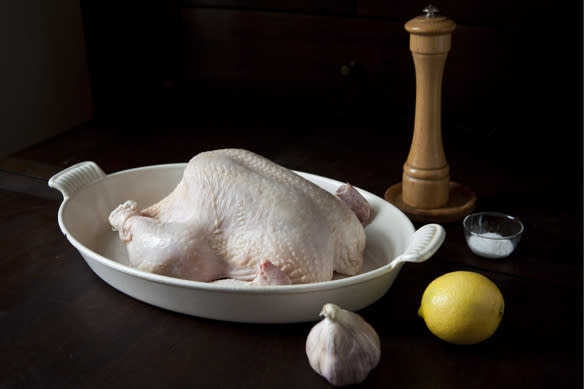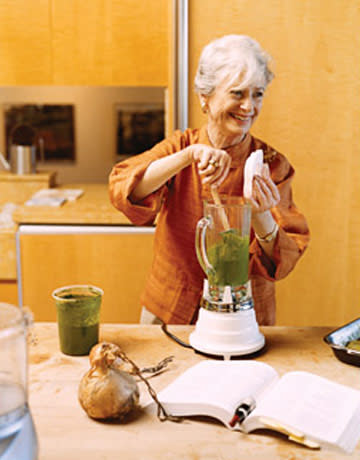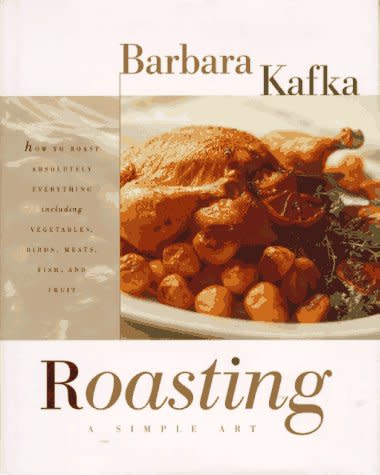The Simplest and Best Roast Chicken
Every week on Food52.com, we're digging up Genius Recipes -- the ones that make us rethink cooking myths, get us talking, and change the way we cook.
Today: No trussing, no basting. It turns out the juiciest and speediest roast chicken is the simplest of all.

- Kristen Miglore, Senior Editor, Food52.com
Choosing one genius roast chicken is a tall, if not impossible, order. You might as well ask a parent to pick a favorite child. They are all special and clever and equally deserving of love, which is why it's taken me this long to commit.
>>RELATED: A Genius Approach to Beef Brisket
Since this column launched, every time I felt the urge to roast a chicken, I knew I couldn't just freestyle, throwing in whatever wayward herb sprigs and scraps of onion I had laying around. Each time, I had to test out a new contender from the Roast Chicken Hall of Fame.
With Judy Rodgers, I pre-salted my bird 2 days ahead. Its flesh was seasoned through to its middle; its juices poured over crusty bread salad. Jamie Oliver had me truss, then slash a chicken's thighs, and they crisped up impressively. With Julia Child, I dutifully flipped and basted, flipped and basted. Simon Hopkinson and I smoothed a whole stick of butter over the top.
With Thomas Keller, I added almost nothing at all, on the premise that any ingredient, even butter, would introduce steam and wilt the skin. Indeed its skin was crackly as wrapping paper. But I had to grumble: this recipe simply told me: "Roast it until it's done -- 50-60 minutes." No internal temperature, no advice to check the juices or wiggle the legs, nothing. Next.
Gradually, just as dating around gives way to comfortable commitment, this experimental time for the chickens and me started to feature a lot of repeat visits from one bird in particular.
The juiciest, speediest, most bewitchingly golden roast chicken also happened to be the one with the recipe I could remember without Googling. Just 10 minutes a pound at 500°F. That's right, 500°F. The whole time.
>>RELATED: How to Carve a Chicken
There's no basting, and no trussing. You needn't remember to turn the heat up or down after so many minutes; nor flip the creature awkwardly halfway through. No snipping of spines or slashing of limbs; no stuffing butter deep into loose corners of skin.
The method is as no-nonsense and fearless as Barbara Kafka herself (her second most famous recipe is microwave risotto). Kafka famously developed her ultra-high heat technique in Roasting: A Simple Art -- not just for chicken and turkey, but everything from strip steak to mackerel to cucumbers. Cucumbers!
Some naysayers have complained about the wild heat, that there's too much spattering or smoke. To them, Kafka just calmly advises (temporarily) unplugging their smoke detectors and setting their ovens to self-clean before they go to bed. I've never had these issues, though I do enjoy the sounds and smells of a sputtering chicken roasting its little heart out.
Don't let the timid out there keep you from tasting this bird -- of all the chickens I've loved, I've never found one better.

Barbara Kafka's Simplest Roast Chicken
Adapted from Roasting: A Simple Art (William Morrow, 1995)
Serves 2 to 4
5- to 6-pound chicken at room temperature, wing tips removed
1 lemon, halved
4 whole garlic cloves
4 tablespoons unsalted butter, optional
Kosher salt, to taste
Freshly ground black pepper, to taste
1 cup chicken stock, water, fruit juice, or wine for optional deglazing
1. Place rack on second level from bottom of oven. Heat oven to 500°F (or for convection, reduce to 450°F).
2. Remove the fat from the tail and crop end of the chicken. Freeze the neck and giblets for stock. Reserve chicken livers for another use.
3. Stuff the cavity of the chicken with the lemon, garlic, and butter, if using. Season the cavity and skin with salt and pepper.
4. Place the chicken in a 12 x 8 x 1 1/2-inch roasting pan breast side up. Put in the oven legs first and roast 50 to 60 minutes, or until the juices run clear. After the first 10 minutes, move the chicken with a wooden spoon or spatula to keep it from sticking.
5. Remove the chicken to a platter by placing a large wooden spoon into the tail end and balancing the chicken with a kitchen spoon pressed against the crop end. As you lift the chicken, carefully tilt it over the roasting pan so that all the juices run out and into the pan.
6. Optional: Pour off or spoon out excess fat from the roasting pan and put the roasting pan on top of the stove. Add the stock or other liquid and bring the contents of the pan to a boil, while scraping the bottom vigorously with a wooden spoon. Let reduce by half. Serve the sauce over the chicken or, for crisp skin, in a sauceboat.
Save and print this recipe on Food52.
Photos by Nicole Franzen





